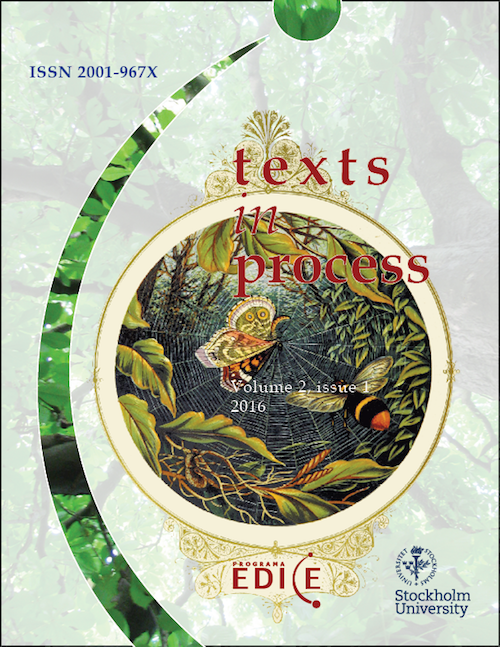Preliminary Research on Discourse Markers and Politeness in the Spanish of the United States
Abstract
This preliminary study determines the dynamics of the discourse markers and politeness in sociolinguistic interviews among Spanish speakers living in the Chicago area. The analysis is based on theories of social relations and politeness strategies (Brown and Levinson, 1987 and Bravo, 1999). By analyzing the markers within the turn organization (i.e. beginning of the turn and during the turn development), this study revealed that speakers make use of three main types of markers: connectors, modals, and appellatives. The findings suggest that the selection of a marker maintains a close relationship with the speaker’s main goal in the conversation. Either, the speaker detaches himself/herself from the interlocutor or he/she gets close to him/her. Thus, the speaker employs mitigation or intensification strategies through various linguistic forms or pauses that appear with the marker or within the turn. This study with Spanish speakers living in the area of Chicago confirms, as other studies in Spanish, that the interaction between markers and politeness is conditioned to the context and the role of the speakers.
Downloads
References
Aaron, J. E. (2004). So respetamos un tradición del uno al otro. So and entonces in New Mexican bilingual discourse. Spanish in Context 1(2), pp. 161-179. http://dx.doi.org/10.1075/sic.1.2.02aar
American Community Survey. (2011). Obtenido de American Community Survey (ACS). Recuperado de https://www.census.gov/programs-surveys/acs/
Bravo, D. (1999). ¿Imagen “positiva” vs. imagen “negativa”? Pragmática socio-cultural y
componentes de face. Oralia, n. 2, pp. 155-184.
Briz, A. (s/f). Atenuación y cortesía verbal en la conversación coloquial: su tratamiento en la clase de ELE. Universidad de Valencia. Recuperado de
Briz, A. (2001). El español coloquial en la conversación. Esbozo de pragmagramática. Barcelona: Ariel.
Brown, R. y Levinson, A.G. (1987). Politeness. Some Universals in Language Usage. Cambridge: Cambridge University Press.
Cepeda, G. y Poblete, M. (2006). Cortesía verbal y modalidad: Los marcadores discursivos. Revista signos, 39 (62), pp. 357-377.
https://dx.doi.org/10.4067/S0718-09342006000300002
Dorta, L. y Domínguez García, N. (2001). Polifuncionalidad discursiva y comportamiento prosódico protípico del marcador pues. Estado actual: Revista de español vivo, n. 75, pp. 45-54.
Fuentes, C. (1996). La sintaxis de los relacionantes supraoracionales. Madrid: Arco Libros.
Grajales Alzate, R. (2011). Funciones del marcador discursivo pues en el habla de
Medellín, Colombia. Forma y Función, Enero-Junio, pp. 25-45.
Grice, H. (1975). Logic and conversation. En P. Cole, y J. Morgan, Syntax and Semantics 3, (pp. 41-58). New York: Academic Press.
Gumperz, J. J. (1982). Discourse Strategies. Cambridge: Cambridge University Press. http://dx.doi.org/10.1017/CBO9780511611834
Haverkate, H. (1991). ¿Cómo aseverar cortésmente? En, Haverkate, H., Hengeveld, K., Mulder, O. y H. Olbertz (eds.). Foro Hispánico: Exploraciones Semánticas y Pragmáticas del Español (pp. 55-68). Amsterdam: Rodopi.
Iglesias Recuero, S. (2001). Los estudios de la cortesía en el mundo hispánico. Estado de la cuestión. Oralia, n. 4, pp. 245-298.
Landone, E. (2012). El alcance interpersonal de los marcadores del discurso en la dinámica
conversacional: el ejemplo de la cortesía verbal. Verba, n. 39, pp. 301-313.
Leech, G. (1983). Principles of Pragmatics. London: Longman.
Lynch, A. (1999). The Subjunctive in Miami Cuban Spanish: Bilingualism, Contact, and Language Variability. Minnesota: University of Minnesota.
Martín Zorraquino, M. A., y Portolés Lázaro, J. (1999). Los marcadores del discurso. En Delmonte, I. y V. Bosque (dir.), Gramática Descriptiva de la Lengua Española (pp. 4051-4213). Madrid: Espasa Calpe.
Muñoz-Molina, A. (2006). Horas decisivas: El español en los Estados Unidos. Enciclopedia del español en el mundo: anuario del Instituto Cervantes 2006-2007 (pp. 723-725). Madrid: Plaza y Janés.
Portolés, J. (1998). Marcadores del discurso. Barcelona: Ariel.
Said-Mohand, A. (2008). A sociolinguistic study of the use of the Spanish discourse marker como (like) in the oral narrative of Hispanic heritage speakers. Revista de Lingüística Iberoamericana, 6 (2), pp. 1-12.
Said-Mohand, A. (2008a). Aproximación sociolingüística al uso del marcador del discurso ‘como’ en el habla de jóvenes bilingües en la Florida. Revista Internacional de Lingüística Iberoamericana, 12 (2), pp. 71-93.
Said-Mohand, A. (2008b). A sociolinguistic study of the use of the Spanish discourse marker Tú SABES (you know) in the oral narrative of Hispanic heritage speakers. Southwest Journal of Linguistics, 26 (2), pp. 67-93.
Sankoff, G., Thibault, P., Nagy, N., Blondeau, H., Fonollosa, M., y Gagnon, L. (1997). Variation in the Use of Discourse Markers in a Language Contact Situation. Language Variation and Change, 9, pp. 191-217.
http://dx.doi.org/10.1017/S0954394500001873
Searle, J. (1969). Speech acts. Cambridge: Cambridge University Press.
http://dx.doi.org/10.1017/CBO9781139173438
Silva-Corvalán, C. (1994). Language contact and change. Oxford: Oxford University Press.
http://dx.doi.org/10.1017/S095439450000168X
Torres, L. (2002). Bilingual discourse markers in Puerto Rican Spanish. Language in Society, 31, pp. 61-83. http://dx.doi.org/10.1017/S0047404502001033
Torres, L., y Potowski, K. (2008). A comparative study of bilingual discourse markers in Chicago Mexican, Puerto Rican, and MexiRican Spanish. International Journal of Bilingualism, 12 (4), pp. 263-279.
http://dx.doi.org/10.1177/1367006908098571
US Census Bureau. (15 de septiembre de 2015). FFF: Hispanic Heritage Month 2015. Recuperado de: https://www.census.gov/newsroom/facts-for-features/2015/cb15-ff18.html
Vinagre Laranjeira, M. (2005). El cambio de código en la conversación bilingüe: la alternancia de lenguas. Madrid: Arco Libros.

Copyright (c) 2016 Tania Constanza Gómez Ríos

This work is licensed under a Creative Commons Attribution 4.0 International License.
Texts in Process (TEP) is a non-commercial open-access scholarly journal governed by a Creative Commons Recognition 4.0 International license. It follows a full and unrestricted open access, without charges or fees for shipping, reviewing, processing and publishing articles. Users can read, download without registering, distribute, print or link the complete texts of numbers and articles, without the permission of the editors or authors. There is also no charge to publish (APCs), being applicable to the entire editorial process. The authors retain their intellectual rights at all times.
ASICE-EDICE Programme has always believed that non-commercial, open, unlimited and unrestricted access to specialized academic publications is a vehicle for academic freedom and scientific rigor. It adheres and shares the Declaration of Mexico and DORA to guarantee the protection of academic and scientific production in Open Access.
















